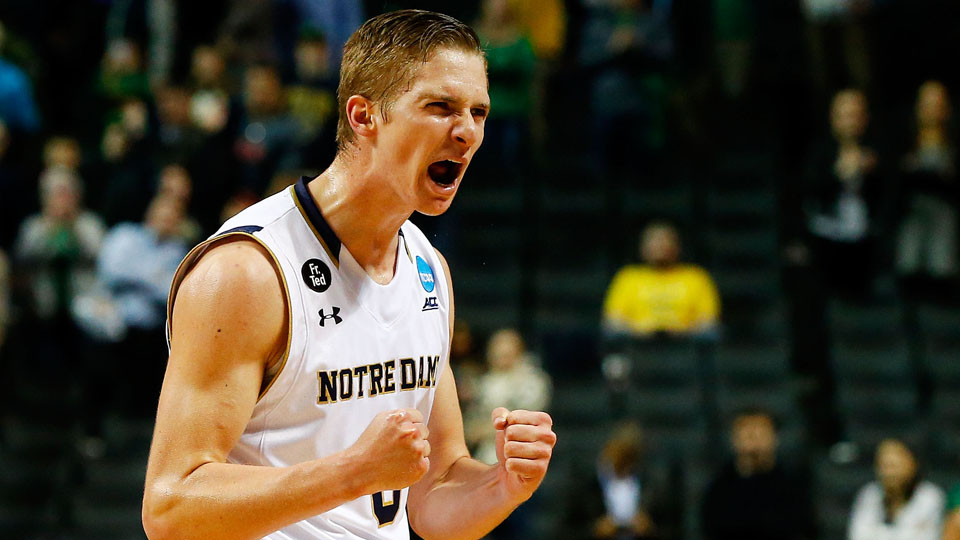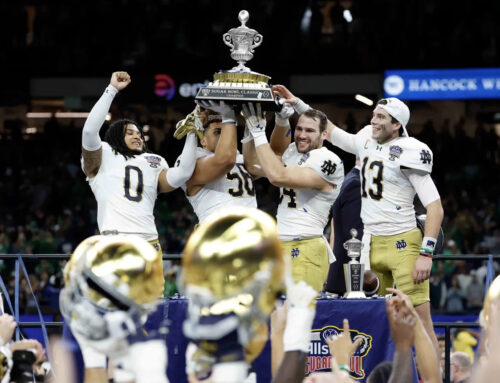Mike Brey’s Notre Dame program has always hung its hat on highly efficient offenses. This year appears to be no different. The Irish are currently the 8th most efficient offense in the nation per KenPom. Where the Irish have struggled is on the defensive end. Due to combination of the lack of athleticism, a lack of effort, and poor fundamentals, ND’s defense has consistently been its Achilles heel. This year’s Irish team has a chance to flip the script, however. The Irish roster has three excellent perimeter defenders between TJ Gibbs, Steve Vasturia, and Rex Pflueger. Unlike a rim shattering dunk or a swished three pointer, excellence on the defensive end is a bit harder to appreciate particularly when so much of it happens away from the ball. Outside of blocks or steals, solid defense doesn’t appear on the stat sheet either. For a better look at the improved Irish defense, check out this possession starring sophomore guard Rex Pflueger.
Setting the Scene
The following defensive possession took place late in the second half of the Northwestern game. After a run by the Wildcats to grab a six point lead, Mike Brey called a timeout to stop the momentum. Out of the TO, Steve Vasturia got in the lane and finished strong at the hoop to cut the lead to four. If the Irish are to mount a comeback, they need to get stops. Rex is matched up with Wildcats guard Bryant Macintosh. Macintosh, a junior point guard, is a double digit scorer for Northwestern and leads the team in assists. When the Cats need a bucket, Macintosh will be the guy pulling the strings.
Start of the Possession
Rex picks up Macintosh around the midcourt stripe. He darts around the Scott Martin “walking screen” by the Northwestern big man, before dropping into his stance. Northwestern starts with a dribble handoff to Isiah Brown. This is relatively simple to navigate, but Rex makes sure to stay tight to Macintosh to avoid accidentally screening Matt Farrell. Pflueger stays tight on his man as the ball swings to Scottie Lindsey the top of the key. Macintosh sets up under the basket at which point Rex goes to work. At eight seconds in the video, Northwestern big man Nathan Taphorn sets a downscreen on Pflueger. Rex gets through it, and stays on Macintosh’s hip denying the catch-and-shoot three pointer. Be sure to note that VJ Beachem sees the screen, and gives Rex a lane to dart through. Macintosh has to get the ball back at the center court logo a good ten feet behind the arc. With half the shot clock gone, Northwestern has to reset their offense 30+ feet from the hoop.
Ball Screen Defense
After getting the ball back, the Wildcats give Macintosh a ball screen at the top of the key. While Taphorn’s screen isn’t great, Rex slides through it easily. He stays in front of Macintosh cutting off any drive to the hoop. Macintosh dribbles back toward the middle of the court where Bonzie Colson’s man, Dererk Pardon, sets another pick. Colson doesn’t hedge particularly well, and he allows Macintosh to get around him. The Northwestern guard has a window to hit the rolling Pardon underneath. Instead Rex gets back to Macintosh and deflects the pass preventing the easy layup.
Finishing the Possession
Pardon grabs the rock, dishes to Macintosh, and screens Pflueger another time. Once again Rex gets through it denying Macintosh a clean look for three. With the shot clock running down, the Northwestern guard drives right with Pflueger with him step for step. Rex forces Macintosh to take a tough midrange pull up jumper. The Irish sophomore gets his hands up to contest the shot, and forces a miss. Macintosh releases to get back on defense, so Rex hangs out in the middle of the lane ready to jump for a rebound. Ultimately, Bonzie cleans the ball off the glass, and the Irish get another chance to cut into the lead.
Appreciating Pflueger’s Defense
Other than the deflected pass, most casual fans might not appreciate Plfueger’s work on this possession, but playing this kind of defense isn’t easy. It is hard to quantify effort in the box score. During this possession, Rex navigates a dribble hand off, a down screen off the ball, three different ball screens, deflects a pass, contains a drive, and forces a tough shot. While recent Irish guards like Demetrius Jackson and Jerian Grant were capable of good defense, especially on the ball, neither were on Rex’s level as a complete defender. Additionally, freshman TJ Gibbs is already showing similar ability, and Steve Vasturia is nearly as tough on defense as Pflueger. The numbers are showing this improvement as well. For the first time since the 2012/13 season, ND has a top 100 defensive efficiency per KenPom. The pressure by the guards is also leading to significantly more forced turnovers. The Irish have their best turnovers numbers since KenPom began tracking them in 2002. Most importantly, they’ve forced more turns (335th nationally last year vs 113th this year) without committing significantly more fouls (11th vs. 15th). Although their defensive rankings may take a hit with tough games against Villanova, Purdue, and all of the ACC still coming, the improvements on defense are definitely a positive sign for the Irish a month into the season.





Awesome recap. The thing that strikes me most about Rex’s defense is his ability to get down in his stance and stay there throughout a possession. There have been a number of current and past Irish players that play defense very upright or come out of their stance when they start to shuffle. Rex stays low, strong, and quick as he moves. His athleticism looks great on his dunk videos, but this kind of defensive effort is going to win the Irish ballgames this year.
Burns is another guy who seems to love to get low and stay low on defense. I’m curious how he looks if/when he gets some more run.
Great work! Love watching Rex play D! Wish there was a stat in College Hoops like WAR in Baseball that shows how valuable elite defense is.
What’s a realistic goal for this year’s defense? As you’ve noted, the defensive efficiency numbers have been pretty atrocious the past couple of seasons despite having some solid individual perimeter defenders. Should we expect a regression to those numbers as the competition increases? Or do you think this is sustainable?
I can see the numbers plummeting quickly. Our best interior defender picks up a foul every 4 possessions. The second best interior defender (Torres) can’t stay on the court because he offers nothing offensively. And we’ve seen the zone get absolutely destroyed by any team that can shoot reasonably from outside the past few years.
At the same time, I could see the perimeter defenders doing enough to really muck up an opponent’s offense for multiple possessions in a row. Not enough to be an elite (or even good) defense, but enough to not be the disaster of seasons past.
Well, they are three points per 100 possessions better than last year’s team, according to KenPom (so, opponent-adjusted), and almost exactly equal to the squad from two years ago. If I remember correctly, that team was far worse until the last month or two of the season, at which point their defensive efficiency numbers skyrocketed (in a good way) to even land at a fairly mediocre season average.
I can’t imagine they will regress to last year’s just based on personnel and what we’ve seen. It’s also probable they are being dragged down a bit from last year’s numbers, which Pomeroy factors in until January, I believe. I think they will end up as quite similar to the team from two years ago but far more consistent. That team was terrible and then good. This team should be fine throughout, not great but not terrible. With their (and the program’s general) offensive productivity, that would almost certainly be good enough to hang around the top 25.
If you look at the raw DE numbers, the Irish currently sit 31st in the land at 91.0, but that’s completely a product of the competition. Adjusted, it floats to 98.6. We’ve played some particularly challenged offenses so far. Colorado, Northwestern and Iowa were 112, 108 and 107.
I think it is way too early to know what this group will do vs. real competition.
The good news is that a better perimeter defense can cover for some sins at the back line because ball pressure can move an offense up off the 3 point line and make entry passes much more difficult. What we lack in great post defense, we might be able to atone for with ball pressure outside.